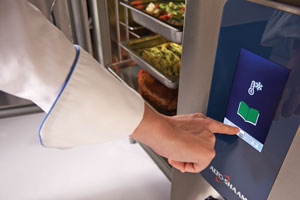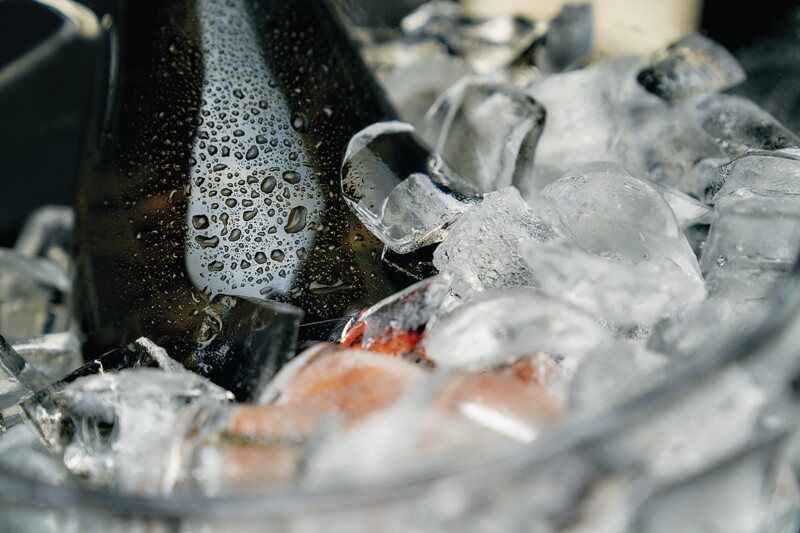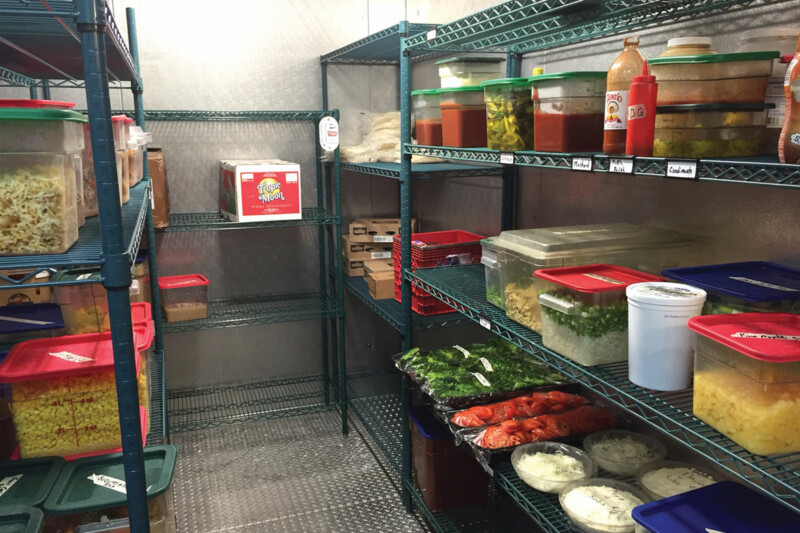
If you’re in healthcare foodservice, you may already have a blast chiller. If your facility doesn’t yet own this equipment, you might be thinking about it. It makes sense considering the huge number of benefits blast chilling/shock freezing can add to a healthcare setting.
When a batch of food is cooled down from its cooked temperature to 37°F in 90 min. (or, in the case of blast freezing, to 0°F in about four hours, depending on the food), there’s far less chance for bacterial growth than there would be if the food passed through the temperature danger zone more slowly, cooling in a conventional refrigerator or freezer. And traditional coolers and freezers are only meant to hold already cold or frozen foods; you’re not supposed to load hot foods into them prior cooling them in an ice bath. Reducing the chance for bacteria to grow (which it does between 135°F and 41°F, doubling every 15 minutes) is important in any context, but especially so for food intended for people whose immune systems are compromised. Mitigating bacteria growth means your foods stay usable longer. Blast chilling can nearly double your foods’ shelf life once it’s on the cooler shelf, again, depending on the product.
Blast chillers not only bring hot food temperature down through the danger zone quickly, but they produce the records you need to prove your hospital is HACCP-compliant in its cooling practices. Almost all models report cooling activity, either transmitting it electronically via a USB port or sending it to a printer for those who prefer hard-copy records.
Blast chilling has myriad other benefits, as well. Because blast chillers bring food items down to cold storage temperature so quickly, there’s less shrinkage. The food retains its moisture because that moisture hasn’t evaporated in the cooling process. Blast-chilled foods retain their full flavor, color, texture and nutritional value. Cooked foods fresh out of the oven will continue to cook for a while. Blast chilling/shock freezing stops the cooking process immediately, which means rare roasts stay rare, vegetables and pasta retain their al dente doneness, fish is delicate and flaky and chicken stays juicy (and won’t turn rubbery). When you re-therm blast-chilled food, it is almost exactly the same as it was just after it was freshly cooked.
Production Efficiency
When paired with a versatile combi oven, a blast chiller enables your operation to cook items in bulk when timing is optimal and when highly-skilled cooks are on the scene. What that means is you can prep volume quantities, ensuring consistency (vs. the inconsistency that can result when different people make batches their own way each day). You also can take advantage of meats or vegetables on sale or in season to cook ahead or simply preserve through batch chilling or freezing.
Blast chillers may eventually be considered essential equipment, not only in healthcare settings but for all commercial foodservice. “The bottom line is that there is no other refrigeration equipment capable of doing what a blast chiller does,” says an engineer with experience in both European and American companies. “Refrigerators, freezers and walk-ins are designed only to maintain foods at 38°F or 0°F, not to cool foods to those temperatures, yet most kitchens are still using refrigerators and walk-ins to bring food temperature down. This is wrong. In Europe they have a law that every industrial kitchen must have at least one blast chiller.”
Air Currents
Blast chillers use one of two methods to chill food. In one system, a fan directs cold air over the pans in a unidirectional airflow, running as much air as possible across the pan surface for maximum cooling efficiency. The other method is an indirect three-way airflow; heat is gradually drawn off the food, boosting cooling consistency throughout the product and minimizing moisture loss. In others words, they either blow air or suck air. How air circulates is a major point of differentiation between makers and the number of makers has grown over the last decade (see “Blast Chiller Specialists,” pg. 10). It should be on your list of questions when you shop for a chiller.
Different types of food require various methods and speeds for optimum chilling. Some programs pull down temperature hard and fast; others cool the food in pulses; others chill gently. These programs typically are called “hard chill” for dense items like a roast or other proteins, a casserole or potatoes, soup or sauce. Makers always recommend chilling items in shallow quantities (2-in. deep product takes an average of 90 min. to chill) but even a 4-in. to 6-in.-diameter roast will chill within four hours. The gentler “soft chill” cycle is used for delicate items such as vegetables, fish, cream-based items, rice and pastries.
With rare exception, all blast chillers also operate as blast or shock freezers. In blast freezers, a “shock freeze” or “hard freeze” cycle uses extremely cold air temperature to pull the food product down to 0°F within minutes or a few hours, depending on the food, the temperature of the food going in, and its density and thickness.
Shock freezing prevents the formation of large ice crystals during the freezing process, and this is a big deal. In slow-freeze situations, water in the foods form macro ice crystals. These crystals break the food’s cell walls. When you thaw the food—be it a juicy steak or a batch of fresh raspberries—most of the food’s natural juices seep out. Shock freezing forms micro crystals, which do not break cell walls. This preserves the foods’ original texture and moisture content and allows for even months-long storage with little to no loss of quality.
No matter what foods you’re chilling, most makes have a series of chilling and freezing cycles designed to bring temperatures down quickly and keep the foods intact, from gelatin desserts and delicate fish to pans of lasagna. For full details on the cycles, see “Just Chillin’,” FER February 2016, http://bit.ly/2fmibxZ.
Blast chillers and freezers also have a “hold” setting, so you don’t have to transfer food immediately to a regular refrigerator or freezer (until, of course, you need the unit to chill the next batch of food). While smaller blast chillers hold full- or half-size pans (no more than 4-in. deep), there also are larger roll-in units that enable workers to quickly move racks of pans or trays with large amounts of product in and out of the chiller. It’s possible to buy a roll-in blast chiller with pan and rack configurations sized for compatibility with the same manufacturer’s roll-in combi ovens and hot holding cabinets.
Some operators actually site a remote-refrigeration blast chiller inside a walk-in cooler, so workers can conveniently unload the chilled food for storage without the cost in extra labor and energy of putting it through a room-temperature environment on the way from cooling to holding. The blast chiller is then immediately available for the next job.
In addition to chilling, freezing and holding, some blast chillers are multi-purpose devices that also warm. A blast freezer that can thaw food overnight is handy—“you can load it up with frozen foods at the end of the shift and thaw under HACCP guidelines with full HACCP reporting,” a product specialist explains. One company features a blast chiller that acts as a proofer, dough retarder and slow cooker as well.
What’s New In The Marketplace?
Blast chillers have changed quite a bit in the past few years, and more upgrades are coming. Many manufacturers name the same key enhancement: new or improved touchscreen controls. Preset menu controls and Windows-based touchscreens have become much more popular. Built-in parameters for frequently chilled menu items allow the operator to spend less time setting programs and also minimize employee training time.
One manufacturer’s units now feature 7-in. LCD screens that allow a more intuitive interface, along with Wi-Fi connectivity that enables a user to monitor the unit’s activity remotely and retrieve HACCP reports. Another company has models with a bigger touchscreen and the opportunity to program, via a USB port, up to 102 settings for specific types of foods and recipes—saving on labor and eliminating guessing games and potential errors. A third company touts its touchscreen controller featuring enhanced functions including thawing, a core probe, temperature and time display, status display, preset programming capability of up to 199 programs, a hot-gas defrost system and HACCP data logging. And yet another manufacturer has a feature that allows chefs to upload photos of specific menu items so staff operating the unit can identify which program to run.
What’s coming next? Wi-Fi capabilities will mean “you’ll be able to download menus, go into programs, actually download instructions from the computer to the blast chiller. That will allow multi-location foodservice operations, like major hospital systems, to keep menus consistent in all locations,” says one expert.
While these sophisticated blast-chiller controls are intriguing, a few simple program icons may be all that’s needed. One manufacturer’s director of sales talks up a blast chiller that allows users to program the fan: “The pickiest of chefs who wants his pastry a certain way can program the speed of the fan and when it starts and stops,” she says. “But this is for operations with a large or changing menu; if you’re just doing the same blast chilling of the same thing every day, it would be overkill.”
What To Look For
A new blast chiller is a pricey affair (well into five figures), so it’s essential to think carefully about your current and future needs and consult with appropriate experts before proceeding. Some things to think about:
• Size. Blast chillers range from 110V countertop and undercounter units to 208V, remote-refrigeration roll-in and pass-thru versions. Many operators soon regret buying a too-small unit, but given that a blast chiller is a major investment and uses a considerable amount of energy, overestimating your current needs also can be an expensive mistake. Start by estimating your production needs—the pounds of food or number of full-size (4-in. deep or less) pans you’re expecting to chill per batch. Generally, one pan equates to 10 lbs. You’ll probably want a unit that holds the same number of pans as your combi oven. Then estimate the number of cycles you’ll run per day. Some operations purchase two smaller blast chillers instead of one larger unit, reasoning that if one unit breaks down, the other is still available. Two units allow you to do chilling and freezing simultaneously. However, if you’re using the blast chiller for shock freezing, you’ll likely only be able to process 50%-65% of the amount of product per cycle as you would in blast chilling mode (depending on the model of blast chiller and depth of the pans; those no more than 2 in.-deep work better than those 2½-in. deep).
• Configuration. What you buy— full size, half size, countertop, roll-in, pass-thru—depends on your menu, your kitchen setup and what you have room for. Manufacturers can advise on the location of your blast chiller, and suggest customization options such as changing which way the door swings. Remember that a roll-in blast chiller requires a floor drain. (Smaller blast chillers have built-in drain pans.) Again, make sure the pan configuration matches that used in your combi oven.
• Simplicity or complexity of function. Do you just want to get a lot of food cold fast, or do you have more complex needs such as soft chilling? Will trained chefs or entry-level employees operate the blast chiller? Do you want multiple recipe settings, or just “on” and “off”?
• Timely delivery and access to parts and service. Many companies manufacture blast chillers overseas, so they may not be immediately available, and it can sometimes be difficult to get replacement parts and knowledgeable service technicians to maintain the unit. Choose a manufacturer that can support you and ask about its service network.
• Probes. One or more probes to determine internal temperature of food will come standard. A fixed probe built into the unit is more accurate, but if a probe breaks off when the blast chiller is being unloaded, replacement can be a pain. Therefore, detachable probes are more durable. Extra probes help you determine whether food is chilling uniformly shelf by shelf, or the rate at which different foods are cooling in different pans—which will help in determining blast chill cycles for your most common menu items. (And you might want to keep extra detachable probes on hand anyway in case of breakage.) You also can get a sous-vide probe that can be inserted directly into vacuum-bagged foods and opt for heated probes that remove easily from frozen items.
• Other options and accessories. UV lights and ozone generators promote sanitation. Casters make smaller units portable, while a roll-in blast chiller may require a ramp.
BLAST CHILLER SPECIALISTS
Alto-Shaam
alto-shaam.com
American Panel
americanpanel.com
Angelo Po
angelopo.com
Carpigiani/Ali Group
carpigiani.com
Delfield/Welbilt
delfield.com
Desmon/Middleby
desmonna.com
Electrolux
professional.electroluxusa.com
Infrico
infrico.us
Irinox
irinoxprofessional.com/usa
Master-Bilt/Standex
master-bilt.com
Randell/Unified Brands
unifiedbrands.net
ThermalRite/Everidge
everidge.com
Thermo-Kool/ Mid-South Industries
thermokool.com
Traulsen/ITW FEG
traulsen.com
Victory Refrigeration/Ali Group
victoryrefrigeration.com
Williams by Beverage-Air/ Ali Group
beverage-air.com
For even more blast chiller specialists, visit the FER Worldwide Buyers Guide at fermag.com.
RELATED CONTENT
- Advertisement -
- Advertisement -
- Advertisement -
TRENDING NOW
- Advertisement -
- Advertisement -
- Advertisement -


